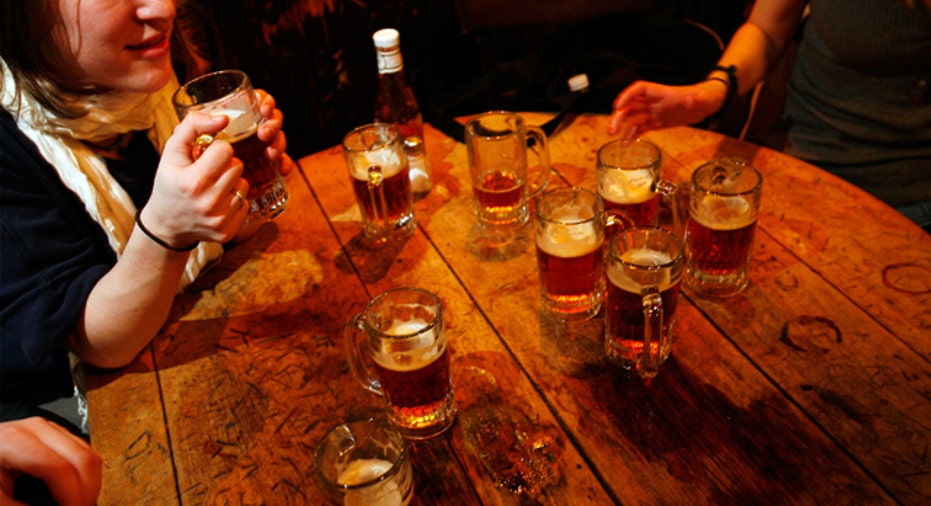Raise a Glass to Higher Beer Prices This St. Patrick’s Day

The luck of the Irish won’t help you get cheaper beer this St. Patrick’s Day with rising commodity prices pushing the cost of the average pint up more than 5% this year.
The price of beer has steadily increased in 2011, posting 2.6% gains in both January and February, according to statistics from the SymphonyIRI Group, a Chicago-based data firm.
Domestic, specialty and non-alcoholic beer prices are up between 5%-8% in the first weeks of March 2011 over March 2010, and up 3%-8% compared to six months ago, according to MyWebGrocer.com
According to the International Monetary Fund, the price of barley, which is used to make malt, a key ingredient in beer, has risen to $196.37 per metric ton in February from $137.30 in the same period last year. Meanwhile, the price of wheat, used in many domestic and international beers, has soared to $348.15 per metric ton last month from $194.54 in February 2010.
Craft beer drinkers will feel the biggest hit with prices up 42 cents per case since last year and premium lagers up 22 cents per case, according to Paul Gatza, director of the Brewers Association.
“Beer prices are up, but it’s not anything the industry hasn’t seen before, and it’s always up to the individual company to make its own decisions on what the price of their beer is going to be,” says Gatza.
Barney’s Beanery, a 90-year old bar and restaurant chain with five locations in Southern California, has watched the wholesale cost of beer rise steadily over the last few years.
“In 2007, there was a big spike in the price of beer--anywhere from 5% to 30%, recalls A.J. Sacher, regional manager for Barney’s Beanery. “The tricky thing about bars passing that on to customers is that with the recession there has been more of a challenge to get customers in, so most bars haven’t wanted to pass that cost onto the people who are there.”
However, Sacher says now that the economy has rebounded somewhat and businesses feel more comfortable about their survival, customers may start to see prices increase, but a lot of that may happen after the Irish holiday.
“St. Patrick’s Day is one of our biggest days of the year,” says David Rekhson, co-owner of Chicago bars Bull and Bear and Public House. “We have noticed a few price increases in the craft beer segment, but that’s not going to be a problem for people on St. Patty’s Day-- 90% of our patrons are going to be drinking green-dyed Bud Light, not beer made by monks in Belgium.”
In 2007, the rise in beer prices was caused by a similar spike in malt and hop prices, leading some brewers to lock into long-term commodities contracts to hedge against fluctuations like what we're seeing today, according to Gatza.
“[Barley and hops] are agricultural crops, so you’re at the whim of mother nature as to how the crops come in,” says Gatza. “When prices are lower, that may benefit the brewers that rely more on the spot market than brewers who are locked into contracts, so contracting has its risks and rewards.”
Generally, the big brewers are the ones with the contracts that last anywhere from one to five years, says Gatza. In 2007, only about 50% of smaller breweries were in long-term contracts for hops, which give artisan beers their distinct flavors. Today, that number is closer to 75%, says Gatza.
At Barney’s Beanery, Sacher says he sees a big difference in pricing on beer from craft breweries and beer standards like Budweiser.
“We have a big variety, 40 beers on draught, between 88 and 100 more in bottles, from 30 different countries and all over the U.S.,” touts Sacher. “In general, craft beers cost us a lot more.”
The average craft beer keg costs Sacher’s bar between $120 to $160, while Budweiser costs around $85 per keg. Large brewers use rice and corn in their beer, according to Sacher, which is typically cheaper than the wheat and barley used by small craft breweries. There’s also more labor and time involved in creating small-batch beer.
At some bars, the reason craft beer costs more is simply because of the formula used to charge per pint. Rekhson said at his Chicago bars, beer is marked up three times what he pays, no matter the type; the more expensive the keg, the more expensive the pint.
“It’s good to have a cut and dried formula,” Rekhson says. “A pint of green Bud will cost around $4 per, but a pint of a craft beer could cost up to $11. It works for us, but it’s not like we have a big ticker in our office where if a keg of bud goes up a quarter our prices instantly rise.”
Rekhson says his bar will continue with their current formula unless the cost per keg goes up by double-digit percentages.
Apart from rising wholesale costs, another thing pushing prices up for bar patrons is fuel surcharges on deliveries, says Sacher.
“When gas prices dropped they went away,” he says. “But they’re coming back now, ranging from $20 to $100 per delivery. Typically those charges make it onto your tab at some point, but it’s not something we feel comfortable doing right now. The most important thing for us at the moment is for people to come into a busy restaurant.”
Yet on St. Patrick’s day, Sacher says patrons can still expect to see deals.
“I don’t think you’ll see a huge difference over last year, but if things keep trending the way they are in economic recovery, next year you will absolutely see a difference. The costs are rising, and it’s up to the bars to determine how to pass them onto the consumer.”



















